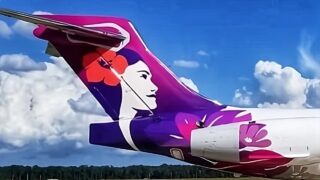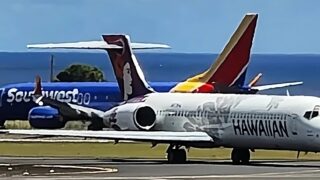If you’ve flown between the Hawaiian Islands in the past 25 years, it’s almost a certainty that you’ve been on a Boeing 717. This short, high-cycle jet quietly became the champion backbone of Hawaii’s interisland travel. But now, an incident involving the 717 and its nose gear failure is back in the spotlight. The final safety report and new federal inspection requirements just came out this week.
While the incident didn’t happen in Hawaii, the implications are landing squarely on the islands. Why? There’s no other airline in the world that relies on the 717 like Hawaiian Airlines (now Alaska Airlines) does.
What happened to a 717 that raised the concern.
On June 28, 2023, a Boeing 717 operated by Delta Air Lines was on final approach into Charlotte when its nose landing gear failed to extend. The pilots circled, attempted a manual extension, and ultimately landed the plane on its main gear with the nose entirely unsupported. All 104 people onboard evacuated via emergency slides as fire crews stood by. Thanks to skilled piloting, no one was injured.
This week, the National Transportation Safety Board released its final report on the incident, bringing the issue back into the news. Investigators traced the failure to a fractured upper lock link—part of the nose gear system that had previously passed inspection. Tool marks from grinding or filing left micro-scratches that triggered a fatigue fracture, which finally gave out after more than 40,000 flight cycles.
FAA directive affects all Boeing 717 planes in the U.S.
The FAA responded by issuing a directive ordering repeated inspections of that part across all remaining 717s in the U.S. The directive specifically affects Hawaiian Airlines, which operates by far the most intensively used 717 fleet in the world.
Credit for first reporting and continuing to cover the incident goes to The Aviation Herald.
Hawaiian’s 717s are in a league of their own.
The aircraft that serves as Hawaiian’s interisland shuttle, “Hawaii’s bus” as it were, was never a Boeing original. It began life as the McDonnell Douglas MD-95 and was rebranded as the 717 after Boeing’s merger with McDonnell Douglas in 1997. Just 156 were ever built. Hawaiian owns and operates 19 of them.
These planes were designed for quick turnarounds and short flights, but probably not this many. Some of Hawaiian’s 717s fly up to 16 cycles per day. That means taking off and landing roughly every hour, sometimes more. Over the past two decades, that has added up to an extreme level of structural stress.
As we explored in this earlier article about high-cycle aircraft in Hawaii, Hawaiian’s 717s have likely already exceeded their original design lifespan in flight cycles.
Sentimental value meets structural fatigue.
Hawaiian’s 717s have earned a reputation for reliability, and the airline has one of the best safety records in the world. That’s part of why some readers strongly believe the aircraft should be preserved.
As one reader named Ricky recently commented, “Re-engine… & re-furbish. Keep ’em flying.”
But aircraft safety isn’t about sentimentality. The part that failed in the Charlotte incident had already been overhauled in 2009 and marked compliant. It subsequently cracked nonetheless.
The FAA directive now mandates that airlines perform repeated inspections to ensure the same thing doesn’t happen again. Hawaiian has not publicly commented on the directive or any fleet adjustments that might follow. But the scrutiny is now firmly fixed on its fleet.
Could anything replace the 717?
That’s the real question, and the answer isn’t simple. Hawaiian, under Alaska’s ownership, has announced no formal plan to replace the 717. Any replacement must handle unique and relentless operations, including constant takeoffs and landings, fast turnarounds, short runways, and sometimes high winds, all with minimal downtime and high cargo throughput.
Reader MikeJ put it bluntly: “This will be a tough call… Only apparent reasonable option is the Embraer 175E2 that potentially could be used for island hopping and then rotated into Alaska’s mainland regional fleet to finish its life.”
Others argue for a more flexible approach. Kyle S suggested the E2 line offers better size options than the larger Boeing 737 MAX 7, which Southwest has struggled with in Hawaii. And reader Norm T pointed out that even small design elements—like the 717’s unique handrail below the overhead bins—make a difference for senior passengers on short flights.
Still, most agree that no replacement will perfectly match the 717. At the same time, the aircraft are just plain old.
Why the economics matter.
While flying aging aircraft may not be a safety issue, it’s definitely an expense issue. Maintenance costs increase with age, especially as inspections become more frequent and parts become harder to source. The recent FAA directive just added one more layer of cost and complexity.
At the same time, it’s a trade-off. New aircraft are very costly and hard to come by. However, they do bring fuel savings, lighter carbon footprints, and often more passenger appeal. However, they also come with retraining requirements and the risk of integrating a new type into an already stretched system.
As one reader, Goforride, put it: “Anything that doesn’t make money will be history… nothing is sacred, nothing is beyond the axe.”
That reality is even sharper now that highly capable Alaska Airlines is in charge.
What Alaska might do next.
The Alaska purchase of Hawaiian means big decisions could come faster now, as Hawaiian was on the verge of bankruptcy when it was purchased. Alaska already operates a streamlined fleet, where the 717 plays no other role. It’s possible that any future interisland fleet would need to integrate with Alaska’s existing aircraft types and maintenance hubs. They haven’t tipped their hat in that regard.
In our earlier story on what Alaska might do with Hawaiian’s short-haul aircraft, readers debated whether the Embraer E175, Airbus A220, MAX 7, or even older A319s might replace the 717. Each has drawbacks—the ability to handle the duty cycles required in Hawaii, cargo capacity, or other factors.
And yet, some still hold out hope. One reader said, “We prefer to fly on Hawaiian to Oahu and then take the shuttle to Maui… we like the two seat option. We fly a minimum of three to four times a year.” For them, comfort and legacy still matter.
What comes next.
The FAA’s directive doesn’t ground the 717. It just makes the costs of keeping it in service harder to ignore. And with the final NTSB report confirming that even “compliant” parts can fail under repeated stress, the message is clear: inspections aren’t always enough.
This isn’t about one incident in Charlotte. It’s about how long planes built a quarter-century ago should continue carrying the bulk of Hawaii’s travelers—and what might replace them before more problems arise.
In some ways, there’s more than a plane at stake here. For many, the 717 is part of the legacy of the Hawaiian Airlines travel experience. But the clock keeps ticking. And with the FAA just stepping in, that’s getting harder to ignore.
We invite your comments on today’s article. Mahalo!
Get Breaking Hawaii Travel News







The E175-E2 is quite a bit smaller than the 717 (80 seats instead of 106). The E190-E2 (97 seats) or E195-E2 (120 seats) would be a better match.
Super Ferry anyone?
Best Regards
Northwest and later Delta post merger operated DC-9-32s that were over 40 years old. They were used into the 2010s. The 717 is the spiritual successor to the DC-9-32, the two planes are very similar in size and are the same basic airframe.
I think Hawaiian’s 717 have more life in them. A successor is not needed immediately. Maybe more a medium range plan, 5-10 years. I’d give my vote to the E2s replacing them, it has proven to be a tough airframe. Of course a turboprop like an ATR would be the most economic, but often lack passenger acceptance.
You need to give credit to Hawaiian Airlines, their pilots, their maintenance crew, everybody. It takes a team to keep an aircraft flying. They’ve done it well.
I don’t see Hawaiian/AAG going out of their way to order a specific type to replace the 717s. Instead i see a Horizon base (Hawaiian Horizon?) of sorts being established and the use of Embraers mixed with Hawaiian A321s (and inevitably 737s) for inter island routing
Once WN 717s come off their leases from DL, I wonder if WN would be willing to release, sell, or part out those remaining 717s to Alaska to keep HA’s inter-island fleet operational?
I would not count on it in the hyper-competitive Hawaiian market, but stranger things have happened.
Using AAG subsidiary Horizon Air to operate turboprops interisland is the clear economic choice here. Speeds are limited to 250 below 10k’ anyways. There is no reason to run jets on these routes. Yes, I know they operate higher than 10k’ for part of the flight.
What turboprops would Horizon Air use? They’ve retired all of them and are exclusively flying the E175. The Q400 isn’t even made right now, and they’re hard to come by. No US airline operates the ATR-72, but they have been used previously.
Note: the 737 MAX 7 (737-7) has not yet been certified. Southwest has been flying 175-seat 737-800 (NG) and 737 MAX 8 (737-8) to Hawaii as their 143-seat 737-700 (NG) fleet is not ETOPS-certified. The higher seat count of the 737-800/8 makes the economics challenging for inter-island flying.
While the U.S. Air Force still flies aging B-52s, I think for commercial airlines, high cycle planes like the Boeing 717 should be retired before we have another Aloha Airline 243 incident or even worse.
While I liked Hawaiian Air’s 717’s 2 + 3 row seating, if the age of the planes are becoming more of an issue, then they should be replaced ASAP. For years the E-175 and the A-220 have been mentioned as a 717 replacement. Choose one and just do it in the name of safety.
As a short term fix, Alaska Airlines could fly its smaller 737-7’s interisland or Hawaiian’s A-321Neo which they do on a few flghts, mostly HNL to OGG.
Change now so we don’t have to live with a statistic and a headline we’ll regret.
(Corrected copy)
Hawaiian does not have the largest 717 fleet. Delta’s fleet of 717s is 4x the size.
Economic$$$ will dictate when/what will replace the venerable 717 as with any airline/airliner ….
The B717s, like their older retired siblings the larger MD-80 series and the much earlier DC-9 family, were designed by McDonnell Douglas to be workhorses. And they were; nearly 1,200 MD-80s were built and served admirably with the major US carriers. But like your 1986 Ford Taurus, these machines have a finite life !! With lead times often exceeding three years, HA/AS need to make a decision. The suggested replacement types all make sense, with the A220 probably the best choice, but timeline & availability may force any decision. Delta, JetBlue, and Breeze have the A220 production line pretty much bottled up at Airbus USA in Mobile Alabama, and Embraer has limited production capacity. So as noted, surplus A319s may need to fill the gap.
Unfortunately Alaska doesn’t exactly exude confidence when it comes to aircraft maintenance. Let’s just hope they keep the same maintenance and management crew intact in Hawaii and keep the 717’s flying.
Wasn’t it mainly improper MX that resulted in the loss of AS261 off the California coast in 2000 ?
Wonder if AS instituted any MX procedure/culture since then…
You mean since 25 years ago?
Be interesting to hear an analysis of the source & quality of the alloy used to make the replacement parts. Odd the article doesn’t mention it.